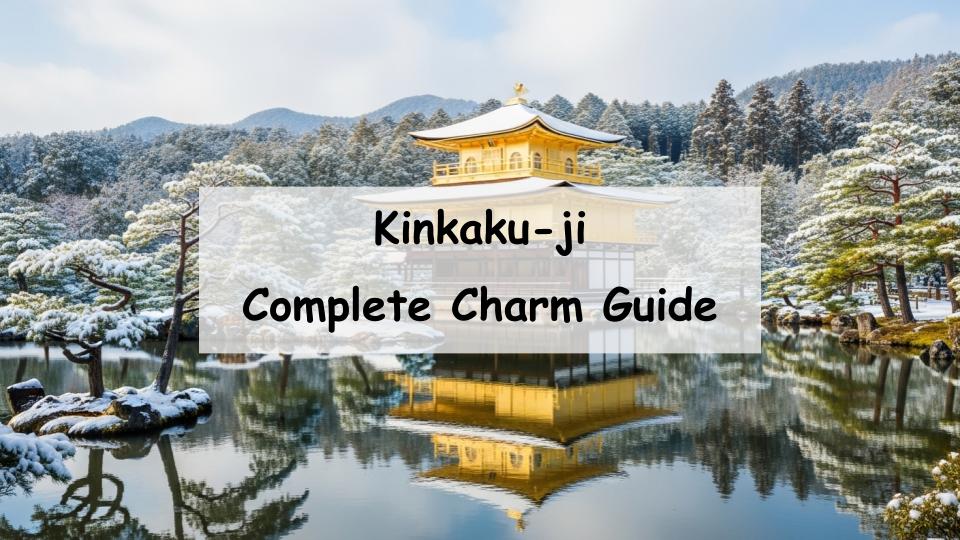“What exactly is Kinkaku-ji? How do I get there? What are the must-see highlights?” — If you’ve found yourself asking these questions, you’re not alone.
To answer briefly: Kinkaku-ji, officially named Rokuon-ji, is one of Kyoto’s most iconic landmarks, known for its golden pavilion and historical significance. Its stunning architecture and seasonal landscapes continue to enchant countless visitors from around the world.
This article offers a complete guide to Kinkaku-ji, including its rich history, unique features, top attractions, how to access the temple, and nearby spots worth visiting. Whether it’s your first visit or a return trip, this article will help you get the most out of your experience.
What Is Kinkaku-ji? History and Key Facts
Official Name and Historical Background
Kinkaku-ji’s official name is Rokuon-ji, a Zen Buddhist temple of the Rinzai sect located in Kyoto’s Kita Ward. Originally built in 1397 as the retirement villa of Shogun Ashikaga Yoshimitsu, it was converted into a temple after his death.
The Connection Between Yoshimitsu and Kinkaku-ji
Ashikaga Yoshimitsu played a central role in the development of Kitayama culture, and Kinkaku-ji was its crowning jewel. His luxurious villa was transformed into a temple, preserving both its beauty and cultural significance for future generations.
Why Is It Covered in Gold Leaf?
The upper two stories of the Golden Pavilion are covered in gold leaf. This design reflects Yoshimitsu’s vision of a Buddhist paradise on earth, symbolizing spiritual purity and showcasing his immense power and wealth.
Highlights of Kinkaku-ji
The Radiance of the Golden Pavilion
The temple’s shimmering Golden Pavilion is its most famous feature. With its three-story structure and gold-leaf facade, it catches sunlight beautifully at different times of the day. Each floor features a unique architectural style, adding to its distinct charm.
The Reflection of Kinkaku in the Mirror Pond
The Kyōko-chi (Mirror Pond) in front of the pavilion creates a breathtaking reflection, especially on still days. The carefully arranged rocks and small islands enhance the sense of harmony between architecture and nature.
Seasonal Beauty Year-Round
From cherry blossoms in spring and lush greenery in summer to fiery autumn leaves and snow-covered landscapes in winter, Kinkaku-ji offers breathtaking views all year. The snow-capped Golden Pavilion is particularly magical and sought after by photographers.
Garden Paths and Teahouse Stops
The temple grounds feature a strolling-style garden, ideal for a relaxing walk. You’ll also find traditional teahouses where you can enjoy matcha and local sweets, making for a peaceful cultural experience.
Collecting Goshuin and Amulets
Visitors can receive goshuin (temple stamps) and purchase a variety of omamori (amulets) for good luck, academic success, and more. These items make meaningful souvenirs and are a cherished part of the temple visit.
How to Get to Kinkaku-ji and Plan Your Visit
Access by Bus and Train
From Kyoto Station, take City Bus No. 205 for about 40 minutes to Kinkakuji-michi Bus Stop, then walk about 5 minutes. Alternatively, take the subway to Kitaōji Station and transfer to a bus.
Access by Car and Parking Info
While driving is possible, the area gets crowded during peak seasons. Several paid parking lots are available nearby. However, public transportation is generally more convenient.
Admission Fee, Hours, and Time Required
Admission is ¥500 for adults, and the temple is open daily from 9:00 AM to 5:00 PM. A typical visit takes about one hour, though longer stays are common if you want to explore thoroughly.
Recommended Spots Near Kinkaku-ji
Combine Your Trip with Ryoan-ji and Ninna-ji
Just a short ride away are Ryoan-ji, famous for its Zen rock garden, and Ninna-ji, another UNESCO World Heritage Site. Visiting these three temples offers a deep dive into Kyoto’s spiritual and cultural heritage.
Explore Nearby Areas: Kitano Tenmangu and Ritsumeikan University
Kitano Tenmangu Shrine, dedicated to the god of learning, attracts many students, especially during exam season. The nearby Ritsumeikan University area has trendy cafes and shops perfect for taking a break.
Local Food and Rest Spots
Enjoy matcha desserts, traditional sweets, and light meals at local cafes near the temple. There are also several restaurants serving Kyoto-style cuisine, ideal for lunch after your visit.
Extra Tips to Enhance Your Visit
Best Photo Spots and Times
For the best photos, visit right at opening time when light reflects softly off the Golden Pavilion and crowds are minimal. The south side of the pond offers the most iconic shot.
Why It’s Popular with Students and International Visitors
Kinkaku-ji is a must-visit spot for school trips and international tourists alike, thanks to its stunning beauty and accessibility. The well-maintained paths and clear signage make it easy to navigate.
Language Support and Signage
The site is equipped with English-language signs and multilingual brochures, making it tourist-friendly for non-Japanese speakers.
Conclusion: Experience the Beauty of Japan at Kinkaku-ji
A Source of Inspiration and Cultural Insight
Kinkaku-ji is more than just a beautiful structure. It’s a place where you can immerse yourself in Japanese aesthetics, spirituality, and history, offering moments of inspiration and reflection.
Your Complete Travel Companion
We hope this guide helps you plan a memorable trip to Kinkaku-ji. With its timeless elegance and cultural richness, your visit will surely be one to remember.










Comment